Ensuring personal safety onboard ship is paramount in maritime environments, particularly for seamen who face unique challenges daily. This article is designed to provide comprehensive guidance on various safety protocols and measures essential for maintaining a secure working environment aboard ships.
- Hazardous Atmospheres
- Personal Protection
- Induction
- Entry into Enclosed Spaces
- Precautions for tank entry
- Procedures for tank entry
- Rescue team enclosed spaces
- Mandatory enclosed space entry and rescue drills
- Personal Protective Equipment (PPE)
- General Safety Precautions
- Breathing apparatus
- Protective clothing
- Safety Data Sheets (SDS)
Whether you’re a seasoned mariner or new to the field, understanding these practices can significantly enhance your safety and well-being at sea.
Hazardous Atmospheres
The need for gas testing
The atmosphere in enclosed spaces will, typically, be tested for oxygen and hydrocarbon content in the following circumstances:
- prior to entry, and on each re-entry, by personnel (with or without protective equipment);
- during gas-freeing, inerting and/or gassing-up operations;
- as a quality control before changing cargoes;
- to establish a gas-free condition prior to inspection and/or repairs.
The atmosphere in a cargo tank is rarely, if ever, homogeneous. With the exception of ammonia and methane, most cargo vapours at ambient temperatures are more dense than air. This can result in layering within the cargo tank. In addition, internal structures can hold local pockets of gas. Therefore, whenever possible, samples will be drawn from several positions within the tank.
Atmospheres that are inert or deficient in oxygen cannot be checked for flammable vapours with a combustible gas indicator. Oxygen concentrations will therefore be checked first, followed by checks for flammable and then toxic substances. All electrical instruments used for such checks will normally be of an approved standard for use in hazardous areas.
Personal Protection
Each member of the ship’s crew has a personal responsibility for safety and a duty to ensure that, as far as possible, they maintain clean, orderly and safe places of work and of living.
The IGC Code lists the minimum requirements for general first-aid and safety equipment to be provided on liquefied gas carriers, as well as additional PPE requirements for individual products carried under the IGC Code.
Read also: Sources of ignition on ships carrying LNG/LPG
Appropriate PPE is supplied by the vessel but will need to be looked after to make sure that it is always ready for use. It will need to be cleaned and dried regularly and stored in a safe place where it can be found at short notice (see point “General Safety Precautions” below).
Appropriate clothing, especially the safety and protective clothing supplied, will need to be worn at all times when at work.
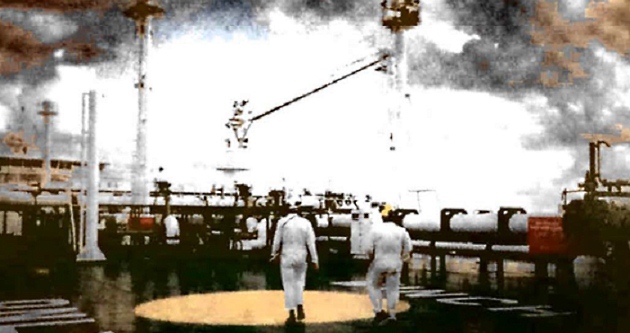
Work hazards include tools and equipment left lying around, cleaning materials not properly disposed of, openings and machinery not properly guarded. It may be prudent to always work on the basis that you could be suddenly called away and therefore not leave anything that could be dangerous to you on returning to the job, to another person who might have to follow you on the job, or to any person entering or passing your place of work.
Induction
The Master of the vessel and the heads of departments will give all assistance in completing familiarisation tours and items to be completed before leaving port, within the first 24 hours and within the first week onboard, but it is prudent for the seafarer to acquire a complete knowledge of the vessel at the earliest opportunity.
Everyone coming on board, even for a short period of time, will undergo an induction process where general safety information is explained.
The following basic areas will typically be covered and a safety familiarisation tour (of these) undertaken:
- muster stations and the location of designated lifeboats, lifejackets, survival suits, liferafts and
other life-saving appliances; - fire-fighting appliances in all work and off duty areas. This will include the identification of appropriate fire alarm activation points;
- the location of safety plans;
- escape routes from on and off duty areas, including from allocated cabin;
- any restricted or hazardous areas;
- designated no smoking areas;
- for new crew, and particularly subcontractors, any locations where access is controlled by permit and the process for obtaining one;
- the location of all safety noticeboards and relevant SDS (see point “Safety Data Sheets (SDS)” below);
- areas where full PPE must be worn.
Familiarisation checklist of bridge, cargo and engine room related items
Each ship will usually have prepared checklists of bridge, cargo, engine room and operations related items that each officer is to be familiarised with before he undertakes a navigational, cargo handling or engine room watch on his own.
Entry into Enclosed Spaces
Chapter 10 of the “International Safety Guide for Oil Tankers and Terminals (ISGOTT)” (Reference 2.4) and Chapter 15 of the Code of Safe Working Practices for Merchant Seafarers (COSWP) (Reference 2.87) describe certain hazards associated with entry into enclosed spaces and the tests to be carried out to determine whether or not an enclosed space has been made safe for entry. The typical conditions for entry are set out, as well as certain precautions to be taken before entry and while work is being carried out in an enclosed space.
Precautions for tank entry
Because of the danger of hazardous atmospheres, an enclosed space will usually only be entered when it is essential to do so. At such times a PTW (see article “Comprehensive Guide to Risk Assessment and Process Safety ManagementPermit to Work Systems (PTW)“) will be issued which will be specific as to date, time and space concerned and list the precautions to be taken.
Particular atmospheres may include:
- amounts of hydrocarbon gas;
- trace amounts of toxic gas;
- the intrusion of inert gas;
- oxygen deficiency (often caused by the rusting process in unventilated tanks).
Table 1 lists those spaces on a gas carrier that are either enclosed or that may be considered hazardous for entry. Note that this is not an exhaustive list. Awareness of potential risks is necessary for all spaces on board ship and, if there is doubt, the space must be treated as dangerous.
| Table 1. Enclosed Spaces on Gas Carriers Include | ||
|---|---|---|
| Enclosed Spaces in Cargo Area | Enclosed Spaces Elsewhere | Enclosed Spaces Entered Routinely |
| Cargo tanks | Void spaces | Compressor rooms |
| Hold spaces | Bunker tanks | |
| Interbarrier spaces | Cofferdams | |
| Duct keels | Ballast tanks | |
| Spaces containing cargo pipes | Spaces adjacent to cargo spaces having unsafe atmospheres | |
| Note: Even if a space is already considered gas-free and fit for entry, where it is immediately adjacent to a tank having a dangerous and pressurised atmosphere, the space should always be entered with caution and only after suitable checks have been made. | ||
In practice, cargo compressor rooms have certain features, such as exit layout, ventilation system, and associated gas detection and safety interlocks, that the other listed spaces do not necessarily have. However, they are included in the list of potentially enclosed spaces in “IMO Resolution A.1050(27), Revised Recommendations for Entering Enclosed Spaces Aboard Ships“, (Reference 1.16) and, therefore, need to be treated in accordance with IMO and industry guidelines.
Procedures for tank entry
Where tank entry is required, every ship and terminal will usually have procedures for safe entry that will be written into operating manuals. Such manuals will, typically, be dear on questions of area responsibility, the shore tanks that should not be entered without the Terminal Manager’s permission and the ship’s tanks that should not be entered without the Master’s permission. As far as the terminal operating manual is concerned, the procedures will typically give advice on terminal operations and the requirements expected from their own, or contracted, personnel when they are visiting or inspecting ships.
Entry into enclosed spaces will usually only be permitted when the atmosphere has been declared gas-free and fit for entry by a Responsible Officer. Only in very exceptional circumstances, when no practical, safe alternative exists, will tank entry be allowed when the tank atmosphere is unsafe. In those circumstances, a risk assessment will usually need to be conducted. The number of persons entering the tank will usually be kept to a minimum – and then only with full protective equipment, breathing apparatus and a safety line for communication and rescue. Further information covering entry into enclosed spaces can be found in ISGOTT, Chapter 10.
Rescue team enclosed spaces
Typically, at least three persons working together as a team are required to rescue a victim from an enclosed space. More may be necessary to rescue a casualty from a cargo tank or hold space.
The rescue operation will depend on the circumstances and can be divided into two basic situations:
- Where the casualty is still breathing when the rescue team arrives. The casualty may be partially conscious or even unconscious.
- Where the casualty has stopped breathing when the rescue team arrives. The casualty will be unconscious.
Every moment is vital but this should not influence the rescue team towards taking unnecessary risks. Unless gravely injured, any physical injury the casualty may have sustained is usually considered of secondary importance. Usually the objective will be to bring out the casualty with the least delay when his physical injuries can be attended to. The restoration of the casualty’s air supply at the earliest possible moment will always be the first priority.
For training purposes, full scale exercises in non-hazardous atmospheres have been found extremely beneficial. Exercises involving weighted dummies, with rescuers wearing protective equipment and breathing apparatus, are essential if rescue teams are to be properly prepared for a real emergency. Such simulations are often conducted by ship’s personnel. They can also involve terminal employees and shore based emergency services, such as the fire brigade.
Mandatory enclosed space entry and rescue drills
Amendments to SOLAS Chapter III/19, that mandate drills for enclosed space entry and rescue, came into force on 1 January 2015.
The amendments add new requirements for seafarers, with directly related responsibilities to participate in an onboard enclosed space entry and rescue drill every two months:
SOLAS CHAPTER III Regulation 19 – Emergency training and drills. 3.3 Crew members with enclosed space entry or rescue responsibilities shall participate in an enclosed space entry and rescue drill to be held on board the ship at least once every two months.
The drills will need to be conducted to accommodate the recommended guidance in Resolution A.1050(27) and must include the checking and using of equipment and instruction in correct procedures, ie:
“3.6.2 Each enclosed space entry and rescue drill shall include:
- checking and use of personal protective equipment required for entry;
- checking and use of communication equipment and procedures;
- checking and use of rescue equipment and procedures;
- and instructions in first aid and resuscitation techniques.”
Personal Protective Equipment (PPE)
PPE will be worn by all personnel engaged in operations on board and ashore. Chapter 8 of COSWP (Reference 2.87) details the various types of protection available for head, hearing, face/eye, respiratory, hand/foot, body protection and protection from falls.
Storage places for PPE, including breathing apparatus, will usually be protected from the weather and clearly marked. Personnel should utilise the equipment and clothing whenever the situation requires.
Personnel who are likely to be required to use breathing apparatus should be trained in its safe use (see point “Breathing apparatus” below).
Ships will need to establish the PPE requirements for visitors, which will include clothing, safe footwear and a safety helmet. Terminals will establish their own requirements for ship’s personnel passing through the terminal. A clearly marked safe route and/or safe transport through the terminal will usually be provided.
General Safety Precautions
Contact with toxic vapour or liquid
Normally, protective suits will be worn and breathing apparatus used when there is a risk of being exposed to toxic vapour or liquid. If in contact with toxic vapour or liquid, the following steps will usually be appropriate:
- remove contaminated clothing immediately;
- wash with large quantities of water;
- inform an officer;
- do not eat, drink or smoke unless you have thoroughly washed;
- always prevent hands coming into contact with your mouth.
See article “Basics of safety on gas carriersPrincipal Hazards” for a further description of the hazards of cold and chemical burns relating to liquefied gas cargoes.
The presence of gas
There is always the possibility of the presence of gases (cargo or inert) in the atmosphere, particularly:
- during loading and discharging of liquefied gases;
- when the ship is gassing-up or being gas-freed;
- when a pipeline or cargo pump is opened up for maintenance;
- in compressor rooms;
- w ithin ballast tanks, void spaces and double bottom tanks adjacent to cargo tanks.
An issue with some gas detectors is that they automatically switch from percent volume to percent lower flammable limit (LFL) at low concentrations. Be sure you know what your meter is reading when you use it!
Dispersion of gas and vapours
Some of the key points to note in this regard are:
- LPG vapours are heavier than air;
- ammonia (NH3) vapours are lighter than air;
- ethane vapours are only slightly heavier than air, which may result in a less discernible layering effect upon a release;
- LNG vapours are lighter than air when warm, heavier when cold (below minus 100 °C (-100 °C)).
In windy conditions, vapours rapidly disperse (this means they dilute to below LFL or OEL). Where there is little air movement, there is a greater danger of flammable or toxic mixtures accumulating and possibly being drawn into machinery spaces or the accommodation.
In still air conditions, flammable or toxic gases may accumulate in potentially hazardous areas. In the event of large accumulations of gas, it will usually be necessary to stop cargo activity immediately and not restart operations until the vapour has dissipated and the hazard removed.
Under these circumstances it will usually be necessary to:
- ensure all portholes and doors are closed;
- carry out orders regarding ventilation openings and air intakes;
- adhere to the ship’s rules and procedures.
Eddies
Air Rowing rapidly past a ship’s superstructure swirls around it, particularly on the lee side. Some of the moving air is drawn into swirling currents known as eddies.
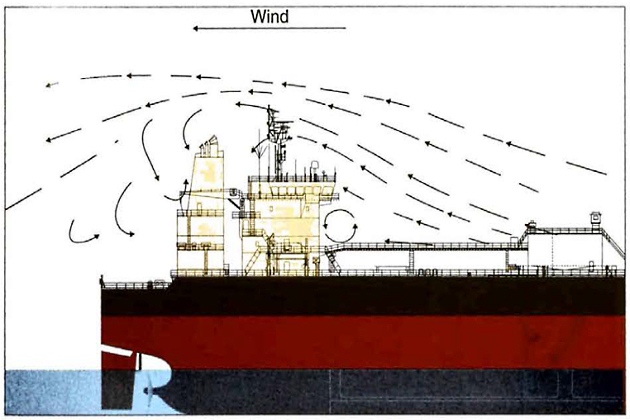
During cargo operations, flammable or toxic gases can eddy and sometimes this can cause pockets of gas to be present in the most unexpected places. Where they form depends on wind speed and direction; a wind blowing from forward may cause gases to accumulate aft of the superstructure.
Toxic products of combustion
Incomplete combustion of hydrocarbon vapours may produce the toxic gas carbon monoxide (CO), which is found in Inert Gas – Definition and Pronunciationinert gas in quantities that can vary with the quality of combustion in the generator. Combustion of VCM may produce toxic carbonyl chloride.
Breathing apparatus
It is always preferable to achieve a gas-free condition in a tank or enclosed space prior to entry by personnel. Where this is not possible, entry into tanks will only be permitted in exceptional circumstances and when there is no practical alternative, in which case breathing apparatus and full protective equipment will need to be worn (see point “Procedures for tank entry” above).
There are three common types of respiratory protection:
- emergency escape breathing devices (EEBD);
- compressed air breathing apparatus;
- canister filter respirators.
Emergency escape breathing devices
This is a small compressed air cylinder and a polythene hood that may be rapidly placed over the head. Their duration is limited to about 15 minutes of comparatively non-exertive effort and in view of this the sets will be used only for emergency escape purposes. Depending on the cargoes specified on the ship’s Certificate of Fitness, EEBD may be provided in accommodation spaces for each crew member. Such equipment may also be supplied for inspections of gas-free enclosed spaces as on aid in case Safety Precautions and Measures on Gas tankersa hazardous atmosphere is encountered or if someone is feeling unwell, although in case of known danger, inspection or entry will usually be mode using compressed air breathing apparatus.
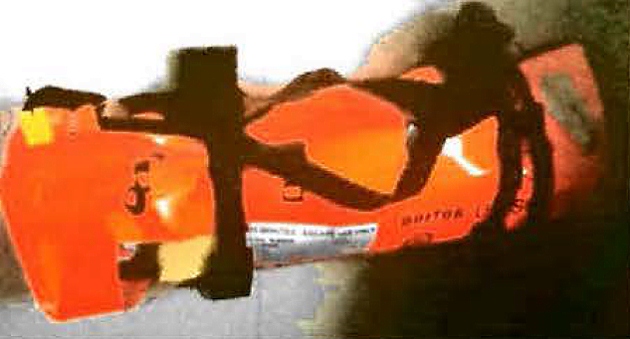
EEBDs are designed only to be used for escape from a comportment that has a hazardous atmosphere. Under no circumstances will an EEBD be used to enter a dangerous space to effect rescue.
Compressed air breathing apparatus
Compressed air breathing apparatus may be adapted into two forms. It may be the self-contained type (SCBA) or the air-line version (ALBA).
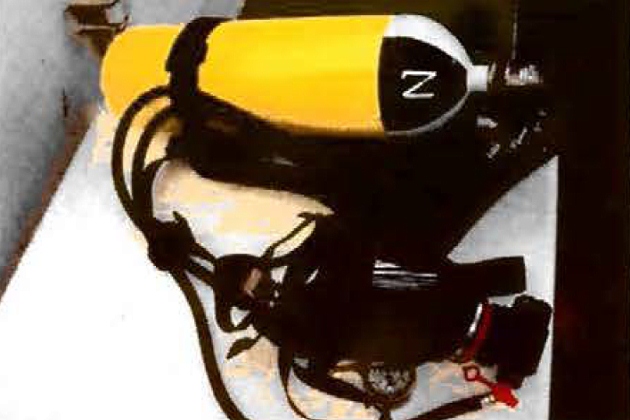
For the SCBA version the wearer carries air for breathing in a compressed air cylinder at an initial pressure of up to 300 bars. The pressure is reduced at the outlet to about 5 bars and fed to the face mask through a demand valve. This provides a slight positive pressure within the mask. The working duration of the equipment depends on the capacity of the air cylinder and respiratory demand. A pressure gauge and an alarm are provided to warn of low air supply pressure. A typical set, providing approximately 30 minutes operation with physical exertion, may weigh about 13 kg and the bulk of the cylinder on the back of the wearer imposes some restriction on manoeuvrability in confined spaces. When properly adjusted, the SCBA is simple and automatic in operation.
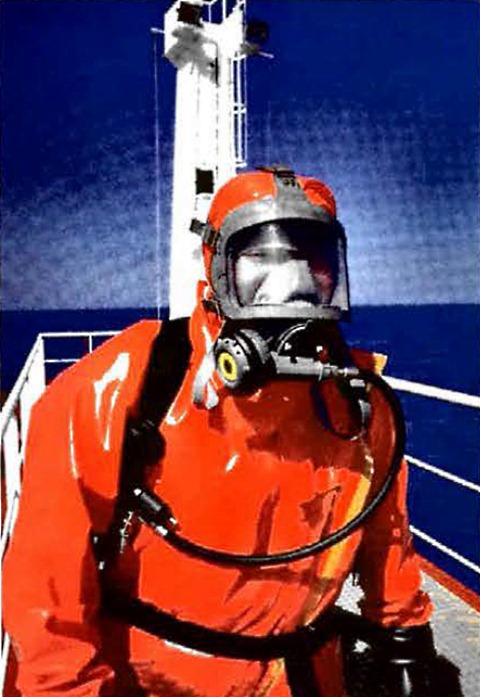
However, maintenance requires care and skill. To ensure serviceability, all such breathing sets will be checked at least monthly and used during exercises. This will usually be done using special exercise air cylinders to keep the operational cylinders always fully charged or, alternatively, a dedicated breathing air compressor may be used for immediate refilling.
Read also: Health, Environment and Safety Management for LNG Transport
Although demand valves are designed to maintain a slight positive pressure within the face mask, it should not be assumed that this feature will prevent a contaminated atmosphere leaking into an ill-fitting mask. It is essential that, before entry into a dangerous space, the air tightness of the mask on the wearer’s face is thoroughly checked in accordance with the manufacturer’s instructions. Tests have shown that it is virtually impossible to ensure continued leak tightness on a bearded face.
For the ALBA version the compressed air cylinder and a pressure reducing valve are placed outside the contaminated atmosphere and connected to the face mask and demand valve by a trailed air hose. At the expense of decreased range and the need for extra care in guiding the trailing air hose, the wearer is relieved of the bulk of the air cylinder. Also, operational duration may be extended by the use of larger air cylinders or special cylinder changeover arrangements.
Canister filter respirators
Canister filter respirators consist of a mask that has a replaceable canister filter attached. In this type of equipment, contaminated air is drawn in by the normal breathing of the wearer and toxic elements are filtered out. They are simple to operate and maintain, can be put on quickly and are used as personal protection for emergency escape purposes on ships certified for carrying toxic cargoes.
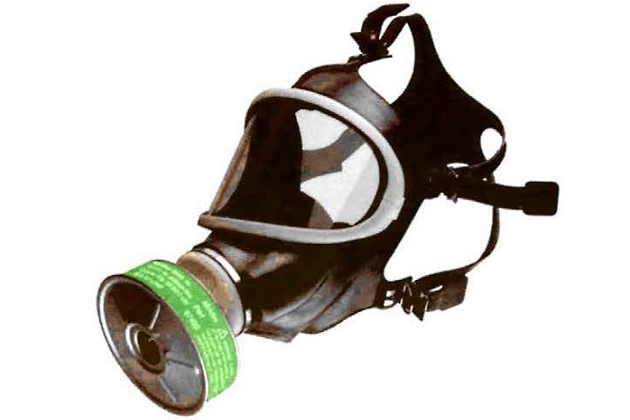
They are, however, only suitable for relatively low concentrations of toxic gas. Once used, there is no simple means of assessing the remaining capacity of the filter. Filter materials are specific to a limited range of gases and the respirator gives no protection in atmospheres of reduced oxygen content. For these reasons, the requirements of the IGC Code for emergency escape protection are now almost exclusively met by lightweight SCBA.
Protective clothing
In addition to breathing apparatus, full protective clothing will be worn when entering an area where contact with a liquefied gas cargo is a possibility. Types of protective clothing vary from those providing protection against liquid splashes to a full positive pressure gas-tight suit that will normally incorporate a helmet, gloves and boots. Such clothing will usually also be resistant to low temperatures and solvents. It is particularly important to wear full protective clothing when entering an enclosed space that has contained toxic gas such as ammonia, chlorine, ethylene oxide, propylene oxide, vinyl chloride monomer or butadiene.
For certain cargoes the IGC Code requires the use of suitable eye protection and clothing that is gas-tight.
Safety Data Sheets (SDS)
The IGC Code requires cargo information, giving the necessary data for the safe carriage and containment of a cargo, to be available to all on board a ship. It is important to realise that different cargo grades may well have different hazards associated with them.
Safety Data Sheets (SDS), also known as Material Safety Data Sheets (MSDS), are used to convey hazard information to anyone who may be involved in the preparation, handling, use and/or carriage of substances or mixtures that may be hazardous or may contain hazardous ingredients.
ANSI recommends that a standard SDS include the following information:
- chemical product identification;
- composition information;
- hazards (main and associated) identification;
- first aid measures;
- fire-fighting measures;
- accidental release measures;
- handling and storage;
- exposure controls/personal protection;
- physical and chemical properties;
- stability and reactivity data;
- toxicological information;
- ecological information;
- disposal considerations;
- transport information;
- regulatory information;
- other information (including date of revision).
While prepared for the chemical tanker sector, further information on the format and content of an SDS will be found in the information paper Safety Data Sheets for Chemical Tankers (Reference 2.58).
